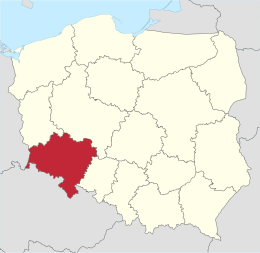

Lower Silesia[1] - a voivodeship with the capital of Wroclaw, located in the southwest Poland, in the Odra valley, at the foot of the Sudetes.
Characteristic
Geography
fauna and Flora
Climate
History
The voivodeship was created after the administrative reform in 1999 from the following voivodeships:
- of the Wrocław voivodeship
- Wałbrzych voivodeship
- Jelenia Góra Voivodeship
- Legnica voivodeship
- Leszno voivodeship (partially)
- Kalisz voivodeship (partially)
goverment administration
The government administration body is the Lower Silesian Voivode. The seat of the voivode is Wroclaw The city has the Lower Silesian Voivodship Office in Wrocław. The government administration of the Lower Silesian Voivodeship is divided into three administrative districts:
| No. | District | Cities subordinate to the district |
|---|---|---|
| 1 | Wałbrzych | Świdnica, Kłodzko, Ząbkowice Śląskie, Dzierżoniów, Bielawa |
| 2 | Legnicki | Glogow, Sycamore, Lupine, Polkowice, Złotoryja |
| 3 | Jeleniogórski | Bolesławiec, stone Mountain, Lubań, Lwówek Śląski, Zgorzelec |
The administrative districts form three former voivodeship cities, they include their former voivodeship territories.
Drive

By plane
By rail
By car
National road No. 8 from the province. Świętokrzyskie. This is the only way.
By bus
Counties
The Dolnośląskie Voivodeship consists of the following poviats:
Town poviats
- 1 – Jelenia Góra (city with poviat rights)
- 2 – Legnica (city with poviat rights)
- 3 – Wroclaw (city with poviat rights)
- 4 – Wałbrzych (city with poviat rights)
Land counties

- 1 – Bolesławiec poviat
- 2 – Dzierżoniów poviat
- 3 – Głogów poviat
- 4 – Górowski Poviat
- 5 – Jawor County
- 6 – Jelenia Góra district
- 7 – Kamienna Góra district
- 8 – Kłodzko County
- 9 – Legnica district
- 10 – Lubański poviat
- 11 – Lubin poviat
- 12 – Lviv district
- 13 – Milicz poviat
- 14 – Oleśnica County
- 15 – Oława district
- 16 – Polkowice poviat
- 17 – Strzelin County
- 18 – Średzki poviat
- 19 – Świdnik district
- 20 – Trzebnica poviat
- 21 – Wałbrzych poviat
- 22 – Wołowski poviat
- 23 – Wrocław poviat
- 24 – Ząbkowicki poviat
- 25 – Zgorzelec poviat
- 26 – Złotoryja district
Regions
Worth seeing
.jpg/220px-Wrocław,_Ostrów_Tumski_(2011-08-14).jpg)

_DSC07758.JPG/170px-Wodospad_Szklarki_latem_(MW)_DSC07758.JPG)
The influences of different cultures, permeating for centuries, are reflected in the architecture of the region. Apart from numerous monuments, the Lower Silesia region also attracts tourists with its beautiful landscapes. Its southern part is covered with mountain ranges: Giant Mountains (with the highest peak Śnieżka - 1602 m above sea level), Jizera Mountains if Table Mountains surprising with unusual landscape relief. They are a perfect place for amateurs of both rock climbing and mountain hiking. Szklarska Poreba and Karpacz are well known to all winter sports enthusiasts, while Kudowa-Zdrój is one of the numerous health resorts in Lower Silesia, valued for its mineral waters and unique microclimate.
The showcase of the voivodeship is its capital - Wroclaw, an active cultural center famous for many music festivals and renowned theaters. Wrocław's Old Town is one of the most beautiful in Europe. Among the numerous monuments of the region, the Cistercian abbeys in Trzebnica and Lubiąż, the baroque basilica in Wambierzyce, the chapel of skulls in Czermna, the wooden church in Świdnica and castles (including Książ, Chojnik, Czocha) stand out.
- Wroclaw - the capital of the region located on the Oder river, famous for its beautiful architecture, with a magnificent Market Square, the Centennial Hall inscribed on UNESCO World Heritage Site and the widely known Zoological Garden;
- Książ - castle located in Wałbrzych it is the largest castle in Lower Silesia and the third largest in Poland;
- Churches of Peace in Świdnica and Jawor - the largest frame-structure religious buildings in Europe are an unprecedented expression of the Lutheran religion, whose followers erected them despite many restrictions imposed on them; are on the UNESCO World Heritage List,
- Karkonosze National Park - covered by the national park, the highest mountain range in the entire Sudetes, popular resorts in Karpacz and Szklarska Poręba;
- Table Mountains National Park - the wealth of rock formations and the gloomy Chapel of Skulls in Czermna;
- Legnica - city, approx. 65 km west of Wrocław;
- Milicz - a town in the northern part of the Lower Silesia Province, in the Milicz poviat, the seat of the urban and rural commune of Milicz, on the Barycz River, famous for its breeding ponds. It is worth seeing the Maltzen Palace and Church of Peace.
- Chełmy Landscape Park;
- Szczawno-Zdrój - picturesque spa;
- Szklarska Poreba - the largest ski resort in the Polish Sudetes;
- Karpniki - a small village in the Jelenia Góra district with a historic church and a castle;
- Silesian Fujijama - an extinct volcano (in the district of Złotoryja, the village of Proboszczów) to the top of which there are stone steps. From the top you can see the entire Karkonosze Mountains, and in good weather and visibility Ślęża.
- Krzyżowa (Świdnica County) - the palace of Helmut James Graf von Moltke from 1720, which has a beautiful, austere neo-baroque shape, is interesting. It stood on a hill above the former Pilawa riverbed. Together with the church and farm buildings, it forms the wings surrounding the park. From 1940, the conspirators against Hitler, "Kreisau Circle", as they were called by the Gestapo, met in the house which stood at the side. Here, in Krzyżowa, the Polish Prime Minister Tadeusz Mazowiecki met with the German chancellor Helmut Kohl in 1989. At that time, a mass of reconciliation between our nations was celebrated, and the sign of peace that the politicians gave each other was a symbolic closure of the tragic Polish-German history.

